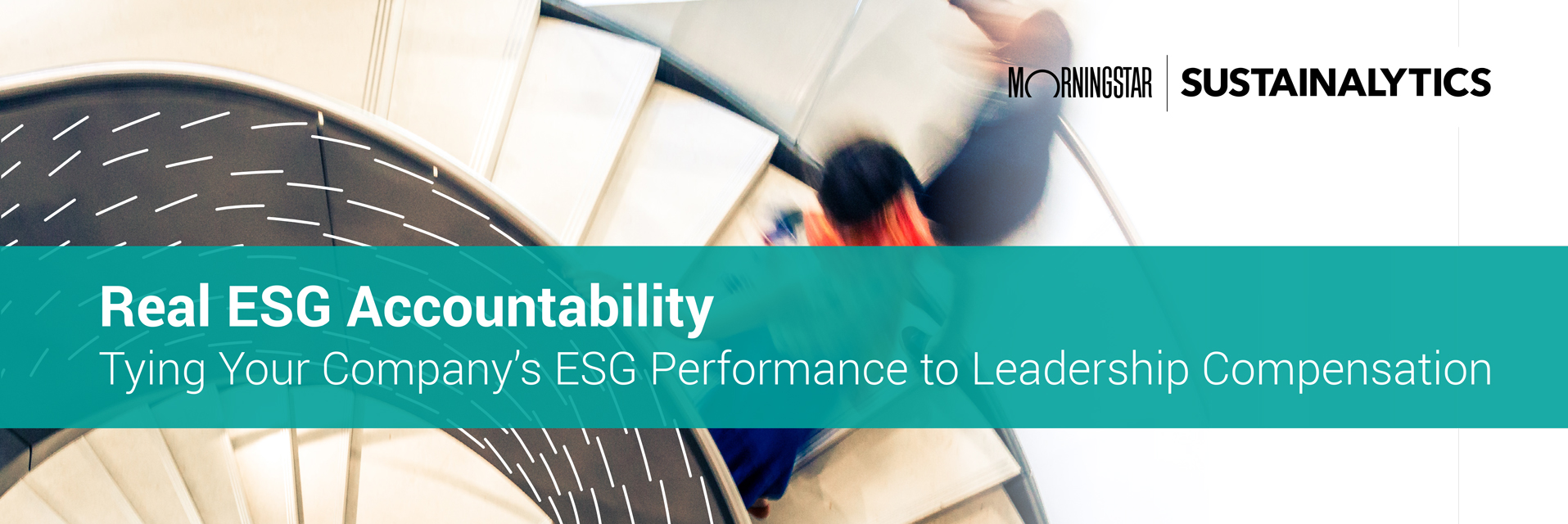There are all kinds of reasons why companies are tying executive compensation to environmental, social, and governance (ESG) performance. Though the compensation metrics used by these organizations differ based on their priorities (or which pillar of ESG they choose to base their targets upon), the reasons are often the same and usually related to enhanced transparency and accountability.
In this Q&A with Sustainalytics’ Upasna Handa, Senior Associate, Product Commercialization for Second-Party Opinions, we take a closer look at the kinds of metrics used by companies to tie executive compensation to ESG performance and some of the related strategic benefits. We also discuss where firms should start if they intend to go down this path.
Sustainalytics: How important is it for corporations to tie their executives’ compensation to ESG metrics?
Upasna Handa: For organizations that want to show they are prioritizing ESG risk management and decarbonization for the long-term success of their business, it is very important. Indeed, many firms have already begun incorporating ESG themes into their business and have made public commitments to increase their ESG investments going forward. 58% of FTSE 100 companies linked ESG measures to executive pay (more than a 30% increase year-on-year) in 2021.1
UH: There are numerous reasons for corporates to tie executive compensation to ESG performance. I’ll touch on a few here.
First, there’s ensuring corporate strategy to reflects ESG priorities. By going through the process of choosing material ESG issues and setting credible targets, companies and their boards and executives can gain immense insight into how to effectively meet strategic priorities.
Second, there’s transparency and accountability. Several stakeholders are interested in the transparent reporting of this process of risk identification and management. Given the focus on transparency within both ESG in general and corporate governance in particular, companies should extend this principle to policies that link ESG programs to their executive compensation formula. Tying variable compensation to ESG performance also provides an additional tool for firms and boards to hold their executives accountable.
And third, there’s financial and reputational growth. Firms that demonstrate meaningful actions on ESG issues can also build trust in the marketplace. Research has also shown that ESG-linked pay is positively associated with shareholder returns, based on analysis on the FTSE 350 between 2009 and 2011, as well as the S&P 500 between 2004 and 2014.2
SUST: What about the industry and regulatory landscape?
UH: In a recent global survey by Willis Towers Watson, more than three-quarters of board members and senior executives identified strong ESG performance as a key contributor to financial performance.3 Many well-known companies have announced linking ESG targets to executive pay over the past two years, including Apple, BP, Chipotle, McDonalds, and Starbucks.
As for the regulatory landscape, in 2021, the United States Securities and Exchange Commission (SEC) Commissioner Allison Herren publicly called for corporate boards to tie ESG metrics to executive compensation.4 Therefore, linking of executive remuneration to ESG goals has become a litmus test for financial regulators assessing whether banks, asset managers, and insurers are taking climate change seriously enough.
Watch out for Part 2 of our Q&A with Upasna Handa, for answers to more questions about ESG metrics and executive compensation. For more insights on the state of ESG pay-links, why companies are introducing ESG-linked compensation, and how to get started, download our ebook, ESG Accountability: Tying ESG Performance to Executive Compensation.
References
1 PricewaterhouseCoopers. 2021. "ESG in executive pay: The evolving landscape." July 7, 2022. https://www.pwc.co.uk/human-resource-services/pdf/esg-in-executive-pay-the-evolving-landscape.pdf.
2 Vivanco, Alvaro. 2022. "Linking ESG to executive pay: companies and investment firms need clearer, more consistent standards." NatWest. July 7, 2022. https://www.natwest.com/corporates/insights/sustainability/linking-esg-to-executive-pay.html.
3 Willis Towers Watson. 2021. "ESG and Executive Compensation: Hearing from board members globally." July 7, 2022. https://www.wtwco.com/-/media/WTW/Insights/2021/04/ESG-and-Executive-Compensation-Report-2021.pdf?modified=20210419083740.
4 Beyoud, Lydia. 2022. "Executive Pay Tied to ESG Goals Grows as Investors Demand Action." Bloomberg Law. July 7, 2022. https://news.bloomberglaw.com/esg/executive-pay-tied-to-esg-goals-grows-as-investors-demand-action.
Recent Content
Q&A | Landmark Rules Ask Companies to Grapple With Climate Risk Very Publicly
Ron Bundy hosts an interview with Gabriel Presler, Global Head of Enterprise Sustainability at Morningstar and Aron Szapiro, Morningstar’s Head of Retirement Studies and Public Policy, to discuss what the new SEC rule and other climate regulations mean.
Q&A | Financing the Future: An Interview on High ESG Risk Industries and Opportunities for Banks
Companies in industrial conglomerates, steel, diversified metals, precious metals, and oil and gas producers can make take meaningful steps to reduce their material environmental, social, and governance (ESG) risk – and the negative impacts that go along with those risks. But they need guidance and access to finance. Read on to learn how banks are working with clients in these high-risk industries to set and meet targets for material improvements on ESG risk factors.






